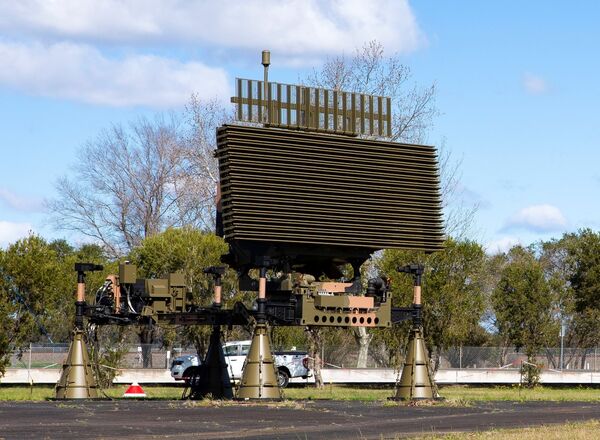- About
- Intara
- Capabilities
- Advisory
- Resources
- News
- Store
Indra delivers deployable air traffic management systems to RAAF
19 April 2023
by Oishee Majumdar


The Lanza 3D medium-range surveillance radar (pictured) is part of two of the three Defence Deployable Air Traffic Management and Control Systems (DDATMCS) delivered by Indra to the RAAF. (Indra)
Spanish technology company Indra delivered three deployable air traffic management systems to the Royal Australian Air Force (RAAF) under the Australian Department of Defence's (DoD's) Project AIR 5341 Phase 1.
The systems, named the Defence Deployable Air Traffic Management and Control Systems (DDATMCS), will enable the RAAF to manage airfield and airspace anywhere during defence missions, as well as during Humanitarian Assistance and Disaster Relief (HADR) operations, Indra said in a media release on 17 April.
Indra said that two of the DDATMCS have two operator positions each and are intended for rapid deployment by air, land, or sea for operations of a short duration, such as military assistance during HADR operations.
“This provides the RAAF with a critical deployable capability to safely support incoming flights when air traffic management infrastructure does not exist or has been damaged by disaster or warfighting,” Indra added.
Azerbaijani artillery using Israeli ELM-2084 as counter-fire radar
17 May 2024
by Jeremy Binnie


A still from a video shows an ELM-2084 radar being deployed during an Azerbaijani artillery exercise. (Azerbaijan Ministry of Defence)
The Azerbaijani Ministry of Defence (MoD) has confirmed its land forces are using a smaller version of the Israeli-made ELM-2084 multimission radar to support artillery units.
An Israel Aerospace Industries (IAI) Elta ELM-2084 was seen clearly in a video released by the MoD on 16 May to show an artillery exercise involving 2S19 Msta-S self-propelled howitzers (SPHs) and 2A36 Giatsint-B towed guns.
Azerbaijan was already known to have an ELM-2084 as one was seen in a video the MoD released in April 2020 showing the radar with the IAI Barak-8 air-defence system deployed north of Baku.
A smaller ELM-2084 was probably glimpsed in television coverage of a visit that President Ilham Aliyev made to a new base in Beylagan in February 2019. A statement released by the president's office said he was shown a “universal radar complex” that is used to support artillery units and monitor enemy fire.
US Army unveils test plan for TRILOS modernisation
10 May 2024
by Carlo Munoz


Multichannel transmission systems operator-maintainers from the 2nd Armored Brigade Combat Team, 3rd Infantry Division, assemble a Terrestrial Transmission Line Of Sight radio system at Fort Stewart in Georgia in August 2019. (US Army )
US Army officials are soliciting industry feedback on the service's technology development strategy to revamp its Terrestrial Transmission Line of Sight (TRILOS) communications equipment, with plans to acquire two to three new TRILOS variants beginning in fiscal year (FY) 2026.
Led by Program Manager Tactical Network (PM TN), the 3 May request for information (RFI) will inform development of the new TRILOS variants.
The variants will feature a radio frequency (RF) base system, “with modular extensions incorporating Free Space Optics (FSO)” to connect with aerial tier assets via a “variable height, mast type configuration”, the 3 May RFI stated. Army officials plan to acquire over 700 modernised TRILOS systems.
DSA 2024: Poly Technologies showcases new armed large unmanned underwater vehicle
10 May 2024
by Vinod Kumar CV


Poly Technologies' UUV300CB LLUV was displayed at the DSA 2024 exhibition in Malaysia. (Janes/Vinod Kumar CV)
China's Poly Technologies has displayed a new multimission-capable large unmanned underwater vehicle (LUUV) at the Defence Services Asia (DSA) 2024 exhibition held in Kuala Lumpur.
According to the company, the LUUV – named UUV300CB – can undertake missions including intelligence, surveillance, and reconnaissance and minelaying operations.
A Poly Technologies official told Janes that the UUV300CB is in development phase and that several variants of the platform could be produced by the company.
A cutaway model of the platform displayed at DSA 2024 shows torpedo tubes, a belly bay for loading EM12-500/1000 mines or UUVs, an image intelligence and reconnaissance mast, an electromagnetic intelligence and reconnaissance mast, sonar systems, and a covered vertical launcher for small missiles in its rear.
Other capabilities include satellite/ultra-high frequency communication and low acoustic signature.
Spanish technology company Indra delivered three deployable air traffic management systems to the Ro...
Latest Podcasts
The value of OSINT for intelligence sharing
In this episode Harry Kemsley and Sean Corbett are joined by Phil Ritcheson Ph.D. to discuss why intelligence sharing is now more important than ever. They discuss the growing need for allied and partnership and how by using open sources facilit...
Listen nowJanes Case Studies
Using Janes Intara to build a common intelligence picture: Russian build up on the Ukrainian border
View Case StudyNews Categories
 C4ISR Details
C4ISR Details